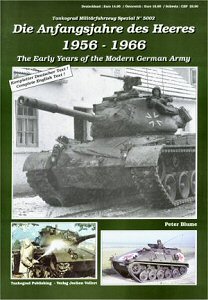

 Die
Anfangsjahr des Heeres 1956-1966 / The Early Years of the Modern German
Army 1956-1966
Die
Anfangsjahr des Heeres 1956-1966 / The Early Years of the Modern German
Army 1956-1966Review by Peter Brown
A bonus is that all the text in printed in both German and English, allowing students of both languages to understand military terms and complex unit designations. It begins with a description of how the early forces were organised, raised and trained with full details of units at all levels including changes during this period. Separate chapters cover each of the main combat arms - infantry, armour, artillery, army aviation etc - tracing their development.
The main portion of the book requires no translation as it has many photos, and captions for then are given in both languages. A wide selection of both black and white and many colour photos show the men but mostly the armaments of the early Bundeswehr, which obtained its equipment from a wide range of sources. Lacking a domestic arms industry when first formed, its early armoured strength came from abroad with American M41, M47 and M48 tanks though their own Leopard was being tested towards the end of the era covered by the book. Other bought-in vehicles included the M113 APC, M7, M44, M55, M42 and later M107 and M109 self-propelled guns and American towed artillery with M4 tracked tractors. Some vehicles were produced for them abroad, such as the HS30 light infantry vehicle and Germany quickly produced its own Kononenjagdpanzer and Raketenjagdpanzer gun and missile-armed tank destroyers.
Some surprises turn up among the early equipment, like ex-WW2 M16-series AA halftracks and M39 utility carriers together with some British Universal Carriers though these (sadly) are not illustrated. The softskin support fleet was German designed and built, using a wide range of vehicles from the small DKW Munga though mid-size Unimog to heavier Faun, KHD and MAN trucks.
Many of these vehicles are available in kit form, using the photos in this book some different "Panzers" can be produced while non-modellers now have details of German forces from this period to fill a gap in the available literature.
The book is published by Tankograd Publishing in Germany. email; jochenvollert@tankograd
Australian
distribution Janterpool Books, PO Box 5128, Studfield LPO, VIC
3152.
North American distribution Military Model Distributors,
1115 Crowley Drive, Carollton, Texas 75006, USA.
UK distributor Bookworld
Page created 1 June 2003